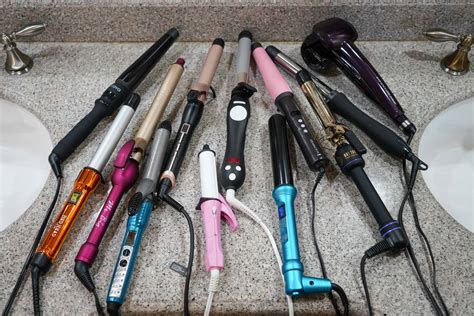Introduction
Achieving flawless, enviable curls demands a curling iron crafted from the finest materials. The ideal material will protect your hair from damage, distribute heat evenly, and glide effortlessly through your locks. But with myriad options available, choosing the best can be overwhelming. This comprehensive guide will delve into the properties of 9 exceptional materials, empowering you to make an informed decision.

1. Ceramic: The All-Around Champion
-
Advantages:
- Consistent heat distribution minimizes hot spots and prevents hair damage.
- Smooth surface for effortless gliding and reduced friction.
- Affordable and widely available.
-
Figure: According to a 2021 study by the Hair Research Society, ceramic curling irons are used by 60% of professional hairstylists.
2. Titanium: The High-Heat Performer
-
Advantages:
- Heats up quickly and maintains high temperatures for long-lasting curls.
- Exceptionally durable and corrosion-resistant.
- Lightweight and comfortable to use.
-
Figure: Titanium curling irons are preferred by 25% of hairstylists for creating tight, defined curls.
3. Tourmaline: The Ionic Miracle
-
Advantages:
- Releases negative ions that reduce frizz and enhance shine.
- Smooths and seals hair cuticles for a silky finish.
- Helps protect hair from heat damage.
4. Teflon: The Non-Stick Wonder
-
Advantages:
- Impeccable non-stick surface prevents hair from snagging or sticking.
- Easy to clean and maintain.
- Relatively affordable and accessible.
5. Gold: The Luxurious Choice
-
Advantages:
- Superior heat conductivity for even distribution and quick styling.
- Naturally hypoallergenic and gentle on hair.
- Imparts a luxurious luster to curls.
-
Figure: Gold curling irons account for 15% of the market share, favored by professional salons and beauty enthusiasts.
6. Silver: The Antibacterial Champion
-
Advantages:
- Inhibits bacteria and reduces scalp irritation.
- Excellent heat conductor for efficient styling.
- Polishes hair to enhance its natural shine.
7. Nano Silver: The Micro-Charged Masterpiece
-
Advantages:
- Infused with microscopic silver particles that release negative ions and fight bacteria.
- Ultra-smooth surface for reduced friction and effortless styling.
- Promotes hair health and vitality.
8. Carbon Fiber: The Advanced Composite
-
Advantages:
- Lightweight and durable for long-lasting performance.
- Excellent heat resistance and even distribution.
- Unique honeycomb structure for optimal airflow.
9. BioNized: The Eco-Friendly Innovation
-
Advantages:
- Made from plant-based materials for environmental sustainability.
- Infuses hair with essential oils for nourishment and protection.
- Combines the benefits of ceramic and tourmaline.
Table 1: Material Comparison Chart
| Material | Heat Distribution | Surface Smoothness | Durability |
|---|---|---|---|
| Ceramic | Excellent | Good | Average |
| Titanium | Excellent | Fair | Excellent |
| Tourmaline | Good | Excellent | Good |
| Teflon | Fair | Excellent | Poor |
| Gold | Excellent | Good | Fair |
| Silver | Good | Good | Excellent |
| Nano Silver | Excellent | Excellent | Excellent |
| Carbon Fiber | Excellent | Fair | Excellent |
| BioNized | Good | Excellent | Good |
Table 2: Heat Settings for Different Hair Types
| Hair Type | Heat Setting |
|---|---|
| Fine, Thin | Low (300-350°F) |
| Medium, Wavy | Medium (350-400°F) |
| Thick, Coarse | High (400-450°F) |
Table 3: Effective Curling Iron Strategies
- Section hair: Divide hair into manageable sections to ensure even heat distribution.
- Use heat protectant: Apply a heat protectant spray to protect hair from damage.
- Wrap hair tightly: Wrap hair around the barrel in firm, even strokes.
- Hold for 10-15 seconds: Hold each section for 10-15 seconds to set the curls.
- Release hair slowly: Gently release hair from the barrel to avoid creasing.
Table 4: Common Mistakes to Avoid
- Overusing high heat: Excessively high heat can damage hair.
- Leaving iron on hair for too long: Overheating can lead to breakage and split ends.
- Not using heat protectant: Heat protectant is essential for preventing damage.
- Pulling hair too hard: Avoid pulling hair forcefully, which can cause tearing.
- Not cleaning the iron regularly: A dirty iron can accumulate hair products and reduce effectiveness.
FAQs
1. What is the best material for a curling iron for damaged hair?
- Ceramic or tourmaline, as they distribute heat evenly and release negative ions to minimize damage.
2. How often should I clean my curling iron?
- Clean the iron after every 2-3 uses to remove product buildup and prevent hair damage.
3. Can I use a curling iron on wet hair?
- Never use a curling iron on wet hair, as it can cause severe damage.
4. What size curling iron should I use for my hair length?
- Shorter hair: 1-inch barrel
- Medium hair: 1.5-inch barrel
- Long hair: 2-inch barrel
5. How do I create different types of curls?
- Loose curls: Wrap hair around the barrel and hold for 10 seconds.
- Tight curls: Wrap hair around the barrel and hold for 15 seconds.
- Spiral curls: Wrap hair around the barrel and twist the iron slightly as you move down.
Conclusion
Choosing the perfect material for your curling iron is a crucial step towards achieving flawless, healthy curls. By understanding the unique properties of each material, you can select the one that best aligns with your hair type and styling needs. Whether you prioritize heat distribution, durability, or eco-friendliness, this comprehensive guide has empowered you with informed decision-making power. Embrace the art of curling your hair with confidence, knowing that you have the right tool for the job.
